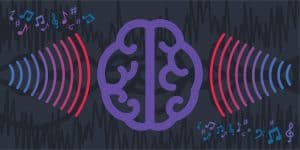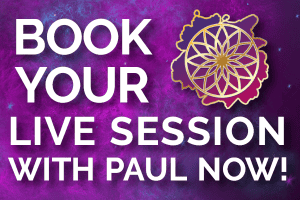
Binaural Beats Brain: A Shutterstock Licensed Image
When the final trickle of sadness evaporated, I became a fan of binaural beats therapy. In just 15 minutes, the unscientific new-age-ness of it all had evaporated and was immediately replaced by a measurable, grounded, and healing experience. I was more relaxed and I felt as though my brain and heart went through a (healing) car wash.
Recently on the fringe of alternative medicine, binaural beats returned to the scene with the backing of double-blind scientific trials, and a long list of brilliant supporters, including scientists, doctors, healers, and patients. What was originally thought to be a fluke in early ear and brain quasi-experiments, has become a powerful, if not profound, treatment for depression and anxiety, and potentially, a variety of physical conditions.
The binaural beats modality is the latest to emerge in “frequency medicine,” a broad category of healing techniques that tune to our body’s rhythms, patterns, sounds, and vibrations in order to gently guide, nurture, and improve them.
Binaural beats are essentially brain entrainment and live under the umbrella of Sound Wave Therapy, which some practitioners and therapists are using for everything from healing seasonal sadness disorder and improving sleep deprivation, to increasing IQ and even helping erectile dysfunction.
Do Binaural Beats Work? You betcha.
Binaural Beats: What is it?
The word binaural comes from the Latin, “with both ears.” The broad definition of binaural beats therapy is: when a person is presented with audio stimulus, there is a change in their brain activity.
More specifically, binaural beats are an auditory experience whereby the receiver listens in a dichotic manner (a unique frequency in each ear), where each frequency is lower than 1500 Hz, and the difference between the two frequencies is lower than 40 Hz.
Because of this dissonance, the listener perceives a cadence or beat that is absent from the audio being played. This can produce a meditative experience whereby the mind, heart, and body become more relaxed. The belief is that if our bodies and hearts are relaxed, they stand a better chance of healing. In most cases, the audio or music file being played in a binaural beats session is melodic, peaceful, and enjoyable.
Some scientists have called binaural beats “tech meds” or “digital drugs,” and they might be right. Patients and devotees of binaural beats say the experience is akin to meditating for 30 minutes, smoking marijuana, or ingesting a small amount of CBD oil.
In all, binaural beats certainly aren’t dangerous and seem to have the potential to help millions of people.
Binaural Beats: How Does it Work?
Brain entrainment occurs when audio or light stimuli are used to coax our minds and hearts into new states of relating to our bodies and spirits. In other areas of science, entrainment occurs when a fluid attaches to and drags other fluids or solids along with it. It can be said that entrainment is where one element inspires other elements to attach to or follow it.
In Jungian psychology, this can be represented by “matching and leading,” whereby the therapist validates and mirrors specific phrases and behaviors in the patient, and then over time, makes healthy adjustments to these phrases and behaviors, thereby matching the patients and leading them to more conscious states of being.
In binaural beats therapy sessions, patients sit comfortably or lay on their backs. The practitioner places headphones on the patient and then plays a series of audio files. Some binaural beats music is melodic and hummable, and some is more akin to ambient, new-age electronic music.
During the session, a FitBit or similar device is used to measure heart rate and brain activity. In most scenarios, the results are clear and decisive: binaural beats therapy is a powerful modality for relaxation and healing.
Binaural Beats Effects & Benefits
- Here are the benefits that are most often reported:
- Sleep Improvement
- Relaxation
- Meditation
- Focus
- Mental Clarity
- Immune System Boost
- Decreased anxiety
- Decreased depression
- Heightened feeling of peace
- Increased life enjoyment
- Binaural Beat Science
While many claim to experience changes in physical conditions, scientific studies are still a little vague on this point. Additionally, science has recently found that binaural beats might not produce any effect on the personality, which this reader finds hard to believe.
One scientist reports that, because the thalamus is not affected during most binaural beat therapy sessions, any improvement in physical, emotional, or mental conditions could be limited, and difficult to prove.
Not all the science points to binaural beats being the new cure-all, but most of the tests show measurable improvements in emotion and mind states.
Some of the more clever healers and practitioners out there are trying to find their own groove and unique value proposition in the market. As such, there is now a variety of repackaged and rebranded binaural beat therapies. While each one seems to march to its own drum, when compared to the basic tenets of binaural beat therapy, their offers are essentially the same.
The military has increased its investment in experimental technologies, especially tech-focused on relaxation and mind/body control. This has tremendous and widespread implications because when the military invests, the business world tends to follow. We’ll see a variety of devices that produce effects similar to binaural beats in the coming months. Body and mind-enhancing tech is finally here to stay.
As binaural beats therapy evolves and as more research is funded, nuances in treatments, technologies, and methodologies will emerge. At present, the results and trends are promising.
Binaural Beat Technologies
If you’re hankering for a hunk of binaural beats tech, there is an emerging pile of technologies that will satiate both ear drums, and more. Here is a list of the headphones with the effective frequency responses for the therapeutic implementation of binaural beats.
- Bose QuietComfort 35
- Audio-Technica ATH-M50x
- Sennheiser HD 202 II
- CozyPhones Sleep Headphones
- Shure SE215-K Sound Isolating Earphones
If you’re into binaural beats science, you might try the Muse and Muse2, which, according to their website, sells “immersive meditation devices that provide real-time feedback on mental activity, heart rate, breathing, and body movements. I love the Muse and Muse2. I have both of them and have found them to be extremely effective for mental, emotional, and physical health improvements.
If you’re interested in the future of humans and consciousness-tech, including binaural beats technologies, check out the Transformative Technologies Conference. It’s an unusually comprehensive event featuring brilliant scientists and those interested in advancing human consciousness.
Binaural Beats In Summary
The Dalai Lama once said, “It takes a long time for me to settle into a deep meditation. If you can invent a device that will help me get into a deep meditative space, I will use it.”
While much of the transformative technologies space is still in early experimentation, the trends in research and the recent release of a long list of products point to a massive paradigm shift. Not only are the emerging technologies aimed at pacifying and healing pained and anxious spirits, they are also hoping to heal the body.
In a matter of five years, this category of technology went from “fru-fru-woo-woo” to powerfully and thoughtfully embedded in scientific research and trials. The next five years will astound us.
Many scientists (artificial intelligence, hardware/software, data science, etc.) who are in the conscious-tech space believe heart rate and brain waves are the key doorways that will lead us to meditative states and improved physical conditions.
While vibrational, energy, and sound healers have believed in (and proven) the power of induced relaxation for centuries, so far, scientific research is still playing catch-up. The belief is simple: When our spirits are peaceful and aligned, our bodies will follow.





